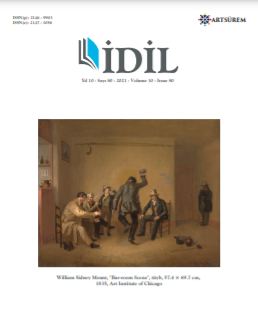ENDÜSTRİYEL DUVAR KAPLAMALARI SERAMİKLERİNDE SELÇUKLU GEOMETRİSİNİN KULLANIMI
THE USE OF SELCUKLU GEOMETRY IN CERAMICS OF INDUSTRIAL WALL COVERINGS
Author(s): Fulya Savaş, S. Sibel SevimSubject(s): Museology & Heritage Studies, Architecture, Visual Arts, Recent History (1900 till today), 13th to 14th Centuries
Published by: Sanat ve Dil Araştırmaları Enstitüsü
Keywords: Geometry; Ceramic coating; Seljuk;
Summary/Abstract: Ceramic coatings (tiles) had been used on the interior and exterior surfaces of the 13th century architectural structures for centuries during the Seljuk Period. These coatings have increased the value of this cultural heritage with not only their rich pattern features but also the extraordinary use of patterns in compositions. The characteristic feature of this period had been constituted by Seljuk's unique understanding of technique and pattern. Especially the most attractive applications of geometric patterns are seen in the decoration of architectural structures belonging to the Seljuks. Geometric patterns, one of the most widely used design elements in wall covering decorations, are very rich in design, technique and variety. These geometric patterns have contributed significantly to our cultural heritage with their extraordinary use by reflecting the richness in pattern diversity, the understanding of infinity and symmetry that have a wide area in compositions, besides their formal features. The transformation of ceramic art into industry in Anatolian soils started in the Republic period. The establishment of the ceramic industry dates back to the planned development periods that started in the 1950s. With the industrial revolution of the 18th century and the development of technology, the start of mass production activities led to the emergence of the ceramic industry and the design requirement. In this period, ceramic art tiles replaced by ceramic coatings. The Seljuk tile art heritage, which forms a bridge for the transfer of cultural heritage from the past to the future, has been a design heritage for the Turkish Ceramic Industry by transferring the art accumulation that has been ongoing for thousands of years from generation to generation, and it also continues to be a source of inspiration for the works in the architecture and ceramics industry today. In this article; the Anatolian Seljuk’s geometry and its usage in today's architecture in industrial wall coverings are examined and the effects of the Seljuk period on today's works are explained.
Journal: İdil Sanat ve Dil Dergisi
- Issue Year: 10/2021
- Issue No: 80
- Page Range: 601-618
- Page Count: 18
- Language: Turkish

